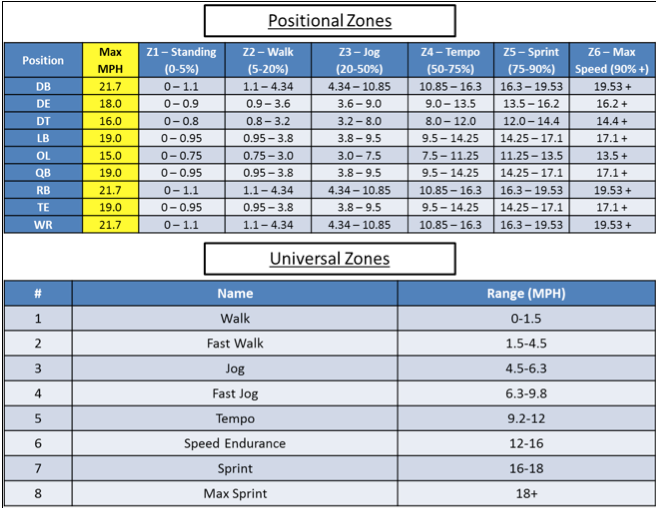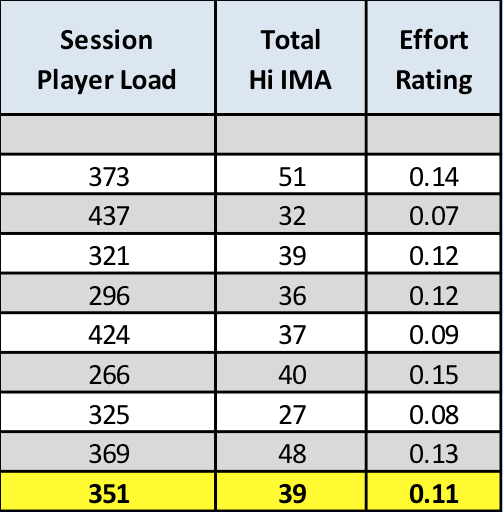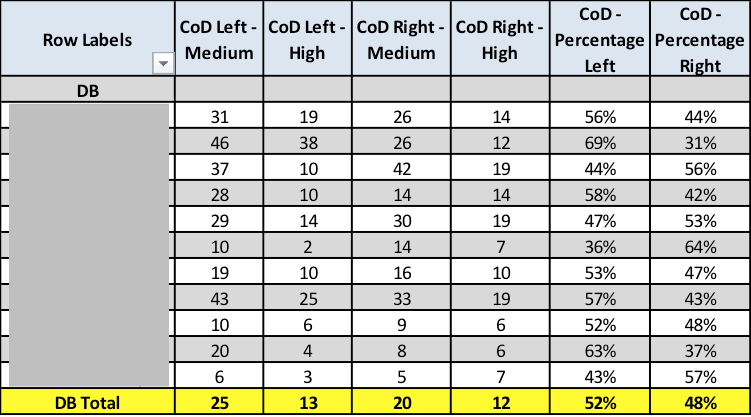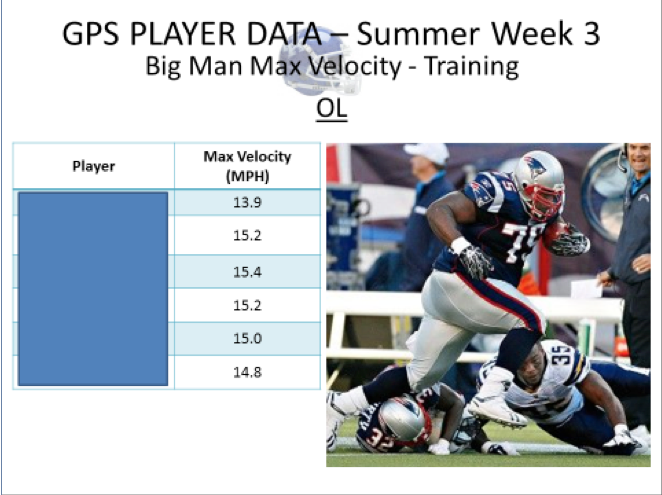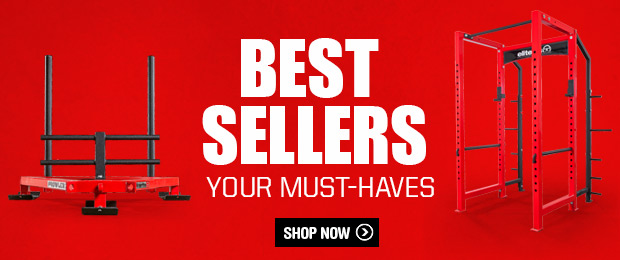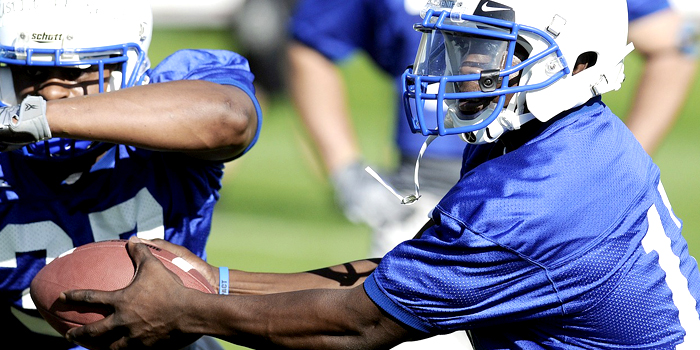
A few years ago, my former boss gave me an opportunity to work with GPS tracking technology, which has since gained immense popularity in collegiate and professional athletics in America. He understood that having this particular skill set would lead to future opportunities, and I have since joined the many in the field using GPS tracking technology while continuing to grow in my primary interest and passion as a strength coach.
Throughout the past few years, I have learned, and continue to learn, what is useful in a day-to-day setting in collegiate football. The biggest thing I've learned is that no technology can ever replace the recruitment of talent and developing a program based around hard work, accountability, discipline and players who never say die (Michigan State comes to mind). As Henry Rollins said, “It’s like putting pearls on a swine. You can dress up a pig, but it’s still a pig.” GPS tracking is essentially useless if you have deficiencies in the aforementioned qualities that winning programs possess. Second to that, I have learned that there isn't any right or wrong way to use the technology (aside from attaching it to barbells or using it for purposes outside its capabilities). If the head football coach wants to make the investment solely for tracking his players’ efforts during practice or training, that's his prerogative. Wins are the only thing that matter.
The purpose of writing this article is to help coaches just starting out with GPS technology and perhaps start some discussion on problems that have presented themselves to coaches who have been tracking their guys for a while. By no means do I consider myself a GPS expert, guru or sport scientist but rather a coach who has used the technology extensively within my environment while encountering many problems, breakthroughs and personalities along the way. In fact, there are many people smarter than I who can offer more insight on the topic.
Note: All images presented below use hypothetical data for display purposes only.
Basic Metrics and Zones
If you are just starting out with GPS tracking, the amount of information received can seem overwhelming at first. Don't attempt to split the atom with this information. Simply select four or five main metrics to get accustomed to. My suggestions are total distance, high speed distance, high speed acceleration (distance), max velocity and player load.
Below are two examples of velocity zones that I've used to help break down the type of work the players are performing.
I recommend using universal velocity zones simply because they are easier to report. I currently use positional zones, which are useful for determining hi speed distance (over 75 percent) for different position groups. The percentage breakdown was developed with Charlie Francis’ work in mind, where anything above 75 percent top speed should be considered high intensity running.
Looking at acceleration and deceleration zones, I only consider anything above 2.25 meters per second in reports (-2.25 for decelerations). One can argue that we should look at lower intensity accelerations for linemen, but that is beyond the scope of this article.
Reporting the Data
Between coaching, recruiting, the media and closed-door meetings that we're happy not to be in, coaches have a lot on their plates. Reporting data must be simple, easily readable, and kept to one page. An elaborate report with multiple spider graphs and an extensive legend will end up in the trash if it even makes it out of a coach’s mailbox. Initially, it can be useful to attach an information page that describes the metrics used in reports that coaches can refer to. First impressions are crucial when you first report the data, so know what you are talking about. Once the season rolls around, it can also be useful to present a weekly report that summarizes the distribution of work throughout the week and notes which periods were most demanding during practice.
The majority of coaches are interested in how hard their guys are working. Your daily reports must accommodate your coaches’ interests and include metrics that reflect the players’ efforts, such as max velocity, high speed distance and high speed effort. As I mentioned earlier, start small and use three or four metrics to avoid overloading coaches with information. Otherwise, they will quickly lose interest.
A metric that I recently added to my reports is something I call an effort rating. It's a function of the sum of total high intensity inertial movement analysis (a catapult feature that captures micro-movements), accelerations, decelerations, and left and right COD divided by player load. Not only is this an arbitrary number that could measure movement efficiency during specialized physical preparation (SPP), but it can be helpful during general physical preparation (GPP) training and “county fair” scenarios when there is less separation between positional requirements (i.e. training against an external resistance as opposed to skills running freely). Below is an example of this metric among a skill group who completed the same drills. It is clear who was more efficient and gave a better effort, hence a higher effort rating. From my observations thus far, a great score is anything over 0.20 during GPP and greater than 0.15 during SPP.
Speaking of player load or any metric that summarizes the amount of work completed, it is important to get coaches familiar with the arbitrary numbers that you will rely on heavily in your analysis and reporting. This is especially useful if you are located in colder climates in which you use an indoor facility regularly. If you can't collect data from GPS satellites during indoor sessions (distance, max velocity, etc.), there must be some consistency in your reporting between outdoor and indoor sessions so that coaches don't have to get accustomed to two different reports.
If you develop reports for the athletic training staff, it is also important to keep their interests in mind. They may be more interested in players’ ability to sustain high intensity efforts throughout a game or practice or very specific information with return to play guys. Players coming off lower body injuries will certainly have an imbalance as they go through their rehabilitation. One approach that could be helpful is developing a percentage metric that shows the difference between limbs on their change of direction work. For example, an athletic trainer may want to see the difference between left and right COD for a player coming off ACL surgery. In our system, this will cover any change of direction above 2.5 meters per second. In Microsoft Excel, it would look like this:
(COD Percentage Left): =IFERROR(SUM($A1:$B1)/SUM($A1:$B1,$D1:$E1),0)
'A' and 'B' are medium and high COD LEFT, respectively, and 'D' and 'E' are medium and high COD RIGHT, respectively. Also, make sure that the number format in Excel is set as a percentage.
Finally, when reporting data, it is important to know your enemy and know your guys. During close games, it is likely that you won't rotate as many guys in and out as you would for blowouts. If you have more than 50 units on guys, you will probably have captured data on the physical requirements necessary to stand on the sidelines for the entirety of a game. It is important to exclude this data from your reports and your database. This may sound like common sense, but if you put together a season summary report for coaches, you don't want useless data affecting your averages.
This past season I had a defensive back who had the highest outputs I have ever seen two weeks in a row. He was a special teams guy who took over the starting role in the secondary, and we had two games in a row with either a lot of kickoffs or a heavy reliance on the defense. His total distance covered over 9,000 yards and roughly 500 yards over 16.3 MPH in two consecutive games. However, this is a guy who needs to get his reps in during practice or he is lost on game day. Therefore, it was crucial that we took care of him in the weight room throughout the week, with a large focus on precise training means and restoration.
MORE Development of Division 1 Football
The point is don't let numbers tell the entire story. Understand your guys and how they operate. If you have an overly aware athlete who gets in his own head too much, don't come at him with a bunch of data displaying how he cuts off one leg harder than the other. No athlete is perfectly symmetrical, and his position may require what the data is showing. You can be doing more harm than good by putting bugs in your athletes’ heads about their physical abilities. Buddy Morris once said in an interview with Joel Jamieson: “I find it hard to believe that you could find a micro-flaw in a movement pattern that’s going to lead to a catastrophic injury later on down the road.”
Player Compliance
You will likely have mixed feelings from the players regarding GPS tracking. Most are neutral on the subject, a few don't care at all and a few take immense interest. Very few will refuse to wear the device. The vanity of wearing the technology will eventually wear off and some players will perceive your interest in prolonging their careers as a burden.
During winter and summer training, creating reports that encourage competition has helped in maintaining interest with the players. It involves the athletes and lets them know that they aren’t wearing the monitors just to wear them. Posting the previous day’s data gets the players talking to each other and provokes competition for the upcoming training.
The amount of buy in from the athletes depends largely on the coach responsible for the technology. In a large way, they are buying you more than the technology, just like they must believe in the strength coach more than the actual training program. Therefore, it is important to be a coach your players trust, someone they know has their best interests in mind. If you are in the trenches with them every day and truly care about their progress as athletes and people, they will gladly wear a silly sports bra for you. However, if they feel like lab rats used for some other agenda, all trust is lost.
Putting your athletes first carries over to game day as well. The guys should be able to focus on only the game. I've found it beneficial to turn the units on and put them in their pads during pre-game before the players are fully dressed and out the door. The units generally last about five hours and this works out pretty well with the pre-game schedule. You may lose some data during overtime games or longer affairs, but don't lose sight of the big picture—your athletes’ mental state and pre-game routines are far more important than any data. Automatic turn-on features that some companies have incorporated now will help alleviate this problem.
I urge anyone with questions to contact me. I will be happy to help. I'll say again that GPS tracking won't result in wins if you don't have a program that emphasizes tough, hard work where every success is earned. There is a fine line between smart and soft, and the overabundance of technology and data can be perceived by athletes as a way to get out of work. By no means am I saying that monitoring your athletes is a bad thing. However, the more I'm flooded with “sports science” material, the more I go back and read books and articles by people like Bill Starr and Dr. Ken, guys who know how to get brutally strong utilizing simple means.
You can read all about tracking and monitoring athletes in Managing the Training of Weightlifters. This was written over 30 years ago when coaches used much less technology than today. My point is a culture of discipline and hard work must be instilled in the program before giving players such luxuries. These athletes must be confident in themselves and in their teammates if they are going to have any success in team sports, especially football. I firmly believe that the weight room is where confidence is developed and players set PRs and carry those over to the field.
Chris Ronald is an assistant strength and conditioning coach for the University of Kentucky football program. He can be reached at chrisronald@hotmail.com.









